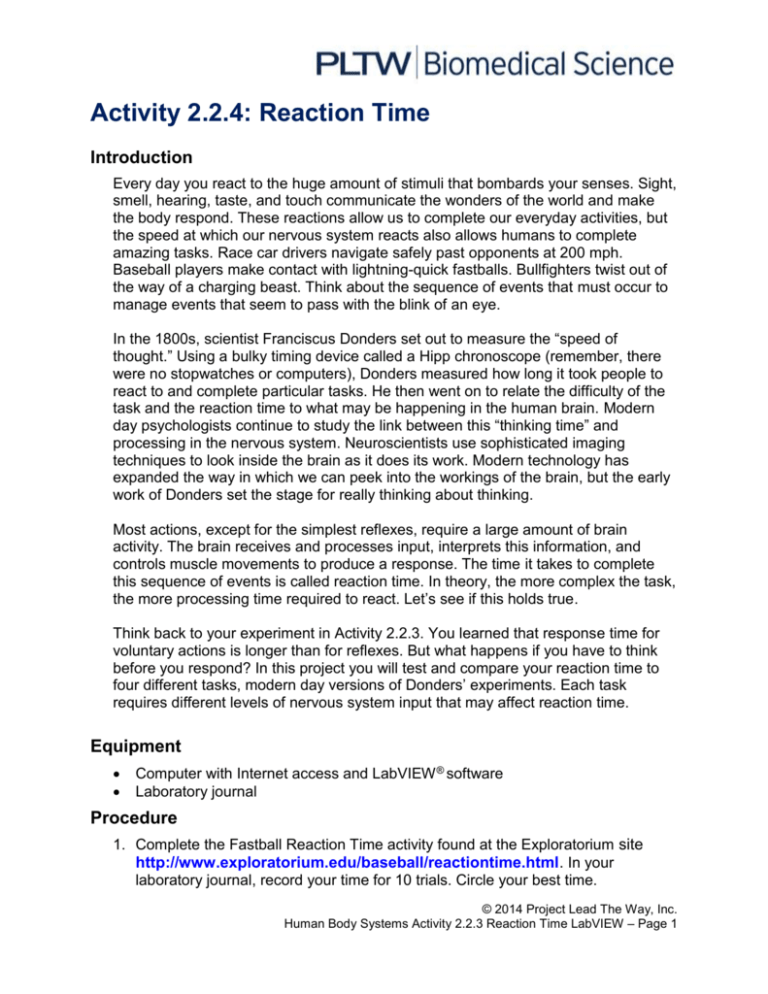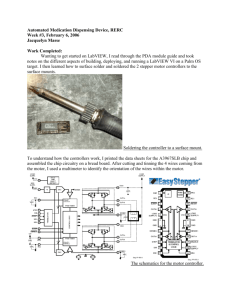P2.2.3.ReactionTime
advertisement

Activity 2.2.4: Reaction Time Introduction Every day you react to the huge amount of stimuli that bombards your senses. Sight, smell, hearing, taste, and touch communicate the wonders of the world and make the body respond. These reactions allow us to complete our everyday activities, but the speed at which our nervous system reacts also allows humans to complete amazing tasks. Race car drivers navigate safely past opponents at 200 mph. Baseball players make contact with lightning-quick fastballs. Bullfighters twist out of the way of a charging beast. Think about the sequence of events that must occur to manage events that seem to pass with the blink of an eye. In the 1800s, scientist Franciscus Donders set out to measure the “speed of thought.” Using a bulky timing device called a Hipp chronoscope (remember, there were no stopwatches or computers), Donders measured how long it took people to react to and complete particular tasks. He then went on to relate the difficulty of the task and the reaction time to what may be happening in the human brain. Modern day psychologists continue to study the link between this “thinking time” and processing in the nervous system. Neuroscientists use sophisticated imaging techniques to look inside the brain as it does its work. Modern technology has expanded the way in which we can peek into the workings of the brain, but the early work of Donders set the stage for really thinking about thinking. Most actions, except for the simplest reflexes, require a large amount of brain activity. The brain receives and processes input, interprets this information, and controls muscle movements to produce a response. The time it takes to complete this sequence of events is called reaction time. In theory, the more complex the task, the more processing time required to react. Let’s see if this holds true. Think back to your experiment in Activity 2.2.3. You learned that response time for voluntary actions is longer than for reflexes. But what happens if you have to think before you respond? In this project you will test and compare your reaction time to four different tasks, modern day versions of Donders’ experiments. Each task requires different levels of nervous system input that may affect reaction time. Equipment Computer with Internet access and LabVIEW ® software Laboratory journal Procedure 1. Complete the Fastball Reaction Time activity found at the Exploratorium site http://www.exploratorium.edu/baseball/reactiontime.html. In your laboratory journal, record your time for 10 trials. Circle your best time. © 2014 Project Lead The Way, Inc. Human Body Systems Activity 2.2.3 Reaction Time LabVIEW – Page 1 2. Discuss the results with the class. Brainstorm the factors that impact reaction time to simple tasks. 3. Open the LabVIEW file titled Donders’ Experiment – Simple Reaction. This task will be referred to as Task 1. 4. Note that each partner will test his/her reaction to a simple color change. Make sure the Number of Events control is set to 20. Directions will appear on the screen when you hit the Run arrow at the top of the page. Use the mouse to click on the appropriate image. 5. Wait a moment after you complete the experiment and statistics for your trial will appear on the right side of the screen. A graph of your response time for each event is shown below. 6. Copy and paste the graph and the statistics cluster into a blank Word document file. Click or highlight the area to copy and select Copy from the file menu on the top of the screen or use “Control C”. Use the Paste command or “Control V” to place the graph or statistics cluster into the blank page. 7. Print this results page. 8. Write the title of the experiment in your laboratory journal and attach your results below this title. Also, note the number of times you clicked at the wrong time. This information is displayed on the side of the graph. 9. If time permits, complete the experiment a second time. If so, make sure to print and attach your results, compare the reaction times of both trials, and discuss any differences in your laboratory journal. 10. Complete Conclusion question 1. 11. Open the LabVIEW file titled Donders’ Experiment – Find Snoopy. This task will be referred to as Task 2. 12. Note that each partner will test their reaction to a discrimination task. In this type of task, you must make a decision before you register a response. Make sure the Number of Events control is set to 20. Directions will appear on the screen when you hit the Run arrow at the top of the page. Use the mouse to click on the appropriate image of Snoopy. 13. Wait a moment after you complete the experiment. Statistics for your trial will appear on the right side of the screen. A graph of your response time for each event is shown below. 14. Copy and paste the graph and the statistics cluster into a blank Word document. 15. Print this results page. © 2014 Project Lead The Way, Inc. Human Body Systems Activity 2.2.3 Reaction Time LabVIEW – Page 2 16. Write the title of the experiment in your laboratory journal and attach your results below this title. Also, note the number of times you clicked at the wrong time as well as the number of times you missed the prompt. This information is displayed on the side of the graph. 17. Compare the results of the simple reaction experiment and the first discrimination experiment. What is the mean reaction time in each case? 18. Open the LabVIEW file titled Donders’ Experiment – Four Squares. This task will be referred to as Task 3. 19. Note that each partner will test their reaction to another discrimination task. Make sure the Number of Events control is set to 20. Directions will appear on the screen when you hit the Run arrow at the top of the page. Click the mouse when you see any combination of only four lights. 20. Wait a moment after you complete the experiment. Statistics for your trial will appear on the right side of the screen. A graph of your response time for each event is shown below. 21. Copy and paste the graph and the statistics cluster into a blank Word document. 22. Print this results page. 23. Write the title of the experiment in your laboratory journal and attach your results below this title. Also, note the number of times you clicked at the wrong time as well as the number of times you missed the prompt. This information is displayed on the side of the graph. 24. On the board write your mean reaction time for Task 1, Task 2, and Task 3 next to your name. 25. Examine the trends and calculate a mean reaction time for each task. Calculate a mean reaction time for each task broken down by gender. List your results in your laboratory journal. 26. Answer the remaining Conclusion questions. © 2014 Project Lead The Way, Inc. Human Body Systems Activity 2.2.3 Reaction Time LabVIEW – Page 3 Conclusion 1. Describe any trends in your simple reaction data. What factors may have attributed to the variation you see over the twenty trials? 2. Compare your reaction time for Task 2 and Task 3. Explain your results. 3. In terms of processing in the nervous system, explain why your reaction time was most likely faster for the reaction task than for either discrimination task. 4. Were there any noticeable differences in reaction times between males and females? If so, what might account for this difference? © 2014 Project Lead The Way, Inc. Human Body Systems Activity 2.2.3 Reaction Time LabVIEW – Page 4 5. How does your reaction time to the voluntary action of your quadriceps in Activity 2.2.3 compare with your reaction time to the simple reaction task in this project? The task in the previous lab involved hearing a sound and reacting with your foot. The task in this lab involved seeing a signal and reacting with your finger. What do reaction times tell you about how these signals are processed? 6. Describe how you could simulate Task 2 or Task 3 from the computer simulation using the basic laboratory setup from Activity 2.2.3. Be sure that the task you design using the EMG sensor and accelerometer represents the same level of discrimination used for that task on the computer. Be creative. Think about what type of cues you want to use. 7. Provide an example of how delayed reaction time can impact other body systems. © 2014 Project Lead The Way, Inc. Human Body Systems Activity 2.2.3 Reaction Time LabVIEW – Page 5




